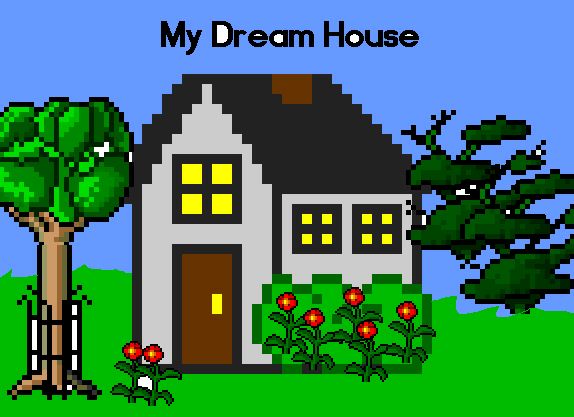
 |
Aims:
1. What are the different types of houses people
live in?
2. In The Big Orange Splot, Mr. Plumbeam
decides that he does not want his house to look like his neighbors'. What
caused Mr. Plumbeam to change the way his house looked?
3. What does "dream house" mean?
4. Can you describe your "dream house," and draw
it using the computer?
5. What are the similarities and differences of
your dream house as compared to Mr. Plumbeam's ?
Vocabulary:
dream house, splot, orange, red, yellow, green, purple,
rainbow, clock tower, hammock, palm trees, ship, hot air balloon, Taj Mahal,
castle, Parthenon
Purpose of the Project:
This lesson will explore homes, cause and effect, the
colloquialism "dream house," and the interpretation of metaphors.
Students will see the
relationship between cause and effect. (When Mr. Plumbeam changed the
way his house looked, what effect did it have on his neighbors?)
Also, to recognize special phrases (idioms) that are unique to English,
and to have students use their imagination, new vocabulary, and computer
skills to create their own unique dream house.
Student Activities:
l. Students will listen and look at pictures in
The Big Orange Splot by Daniel Manus Pinkwater.
2. Students will discuss question: "What
made Mr. Plumbeam repaint his house? " They will see relationship
between the paint being dropped, and Mr. Plumbeam changing his house into
his dream.
3. Students will use a Character Traits Web (Graphic
Organizers For Reading and Writing by Macmillan/McGraw Hill) to describe
Mr. Plumbeam. (See http://teachersnetwork.org/teachnet-lab/ps101/mcquade/characterweb.htm).
4. Students will use a Word Map (Graphic Organizers)
to describe what a "dream house is. (See http://teachersnetwork.org/teachnet-lab/ps101/mcquade/wordmap.htm).
5. Students will use pattern blocks to create own
unique dream house.
6. They will use Magnetic Way to become familiar
with the names of kitchen and yard furniture.
8. They will transfer knowledge of houses as in
Homes lesson
http://teachersnetwork.org/teachnet-lab/ps101/mcquade/homes.htm
to assist them in finding, drawing and printing pictures
of their dream houses on Kidpix and Stanley's Sticker Stories.
9. They will use new vocabulary to describe their
unique dream house and create a graph to categorize different types of
dream houses.
Materials:
The Big Orange Splot by Daniel Manus Pinkwater, Kidpix,
Stanley's Sticker Stories, poster of "Our House" fingerplay,
http://teachersnetwork.org/teachnet-lab/ps101/mcquade/ourhouse.htm
Character Traits Web by Macmillan/McGraw Hill, (see word
map http://teachersnetwork.org/teachnet-lab/ps101/mcquade/characterweb.htm),
Standards Addressed:
1. Students will read, write, listen
and speak for information and understanding.
2. Interpret information represented
in pictures, illustrations, and simple charts and webs.
3. Use a picture dictionary as a resource
for vocabulary.
4. Point to words in a text or on a
chart when read aloud, matching spoken word to print.
5. Use computer software to support
early reading development and early writing skills.
6. Create a drawing, picture, sign,
or other graphic to represent a word or concept.
7. Use classroom resources (word walls,
picture dictionaries, teachers, peers, to support the writing process.
8. Take turns speaking in a group.
9. Correct the pronunciation of words
by using classroom resources, such as teachers, peers, audio/and video
tapes, and computer software.
Resources:
Macmillan/McGraw-Hill, Graphic Organizers for Reading
and Writing, New York 1976,
Scholastic Inc., Banners-Homes, New York, 1991,
Creative Publications, ThemeWorks-Houses, Mountainview,
Cal., 1991
Scholastic Inc., The Big Orange Splot, New York
1997
Lesson 2: How is a house built?